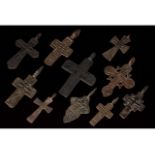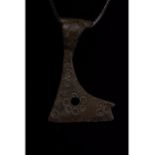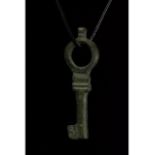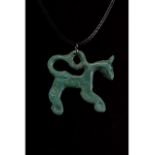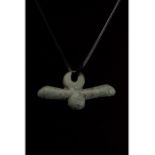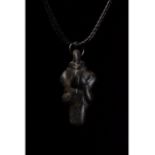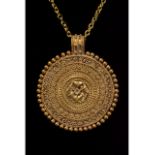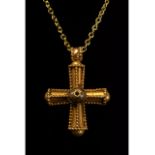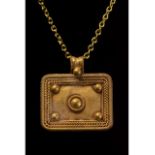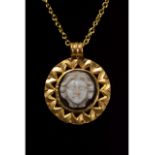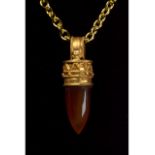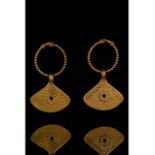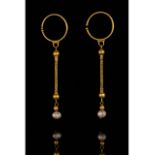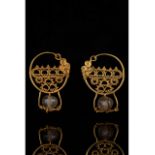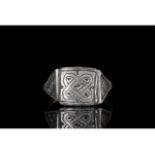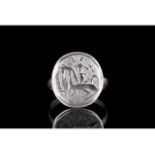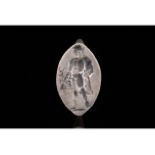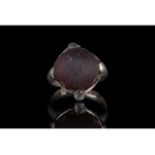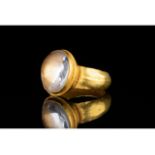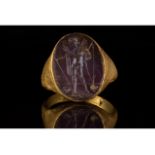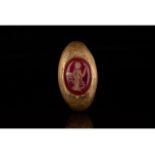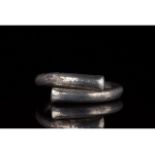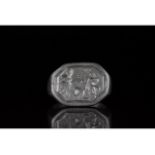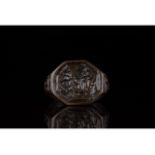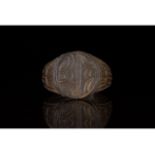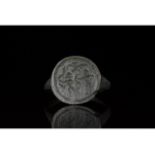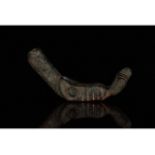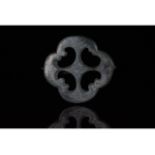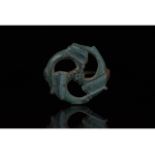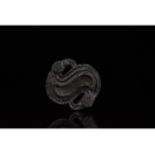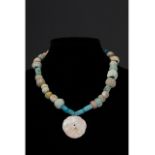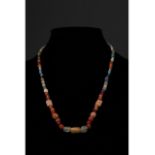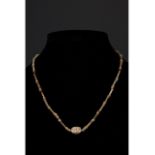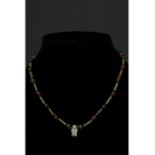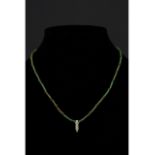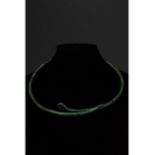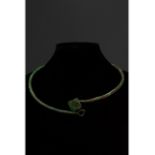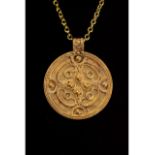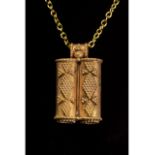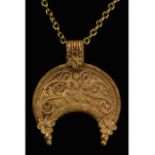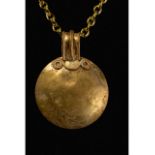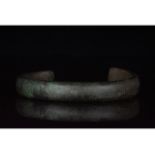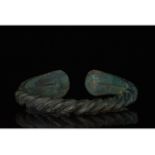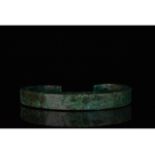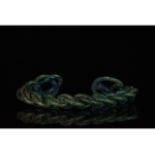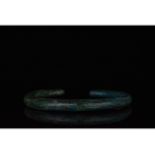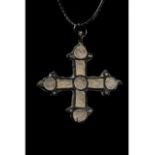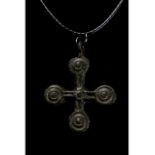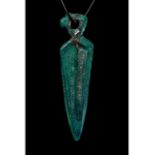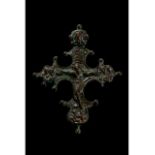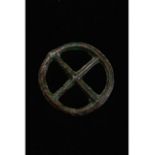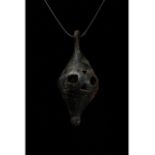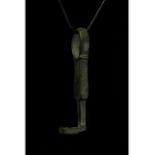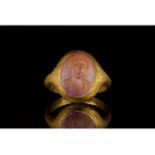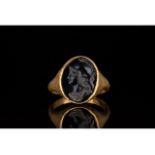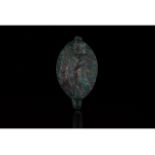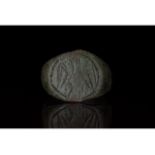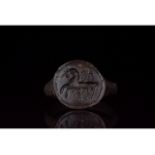Refine your search
Estimate
Category
- Arms, Armour & Militaria (123)
- Jewellery (90)
- Greek, Roman, Egyptian & Other Antiquities (39)
- Sculpture (20)
- Collectables (15)
- Scientific Instruments (14)
- Glassware (13)
- Salvage & Architectural Antiques (12)
- Metalware (10)
- Coins (9)
- Ceramics (4)
- Vintage Fashion (4)
- Musical Instruments & Memorabilia (3)
- Silver & Silver-plated items (2)
- Sporting Memorabilia & Equipment (2)
- Textiles (2)
- Books & Periodicals (1)
- Stamps (1)
- Tools (1)
- Wines & Spirits (1)
Filtered by:
- Item Type
- List
- Grid
A subscription to the Price Guide is required to view results for auctions ten days or older. Click here for more information
1300-1700 AD, Late medieval/post medieval. A lot of ten metal crosses of varying forms and styles. The Cross is the principal symbol of Christiani...
VIKING BRONZE AXE-SHAPED PENDANT
700-1100 AD, Viking Age. A bronze example of an axe or Perun amulet comprising a suspension loop and a stylised axe with a notched head, and impre...
ROMAN BRONZE KEY PENDANT
100-300 AD. Roman. Bronze key pendant with circular suspension loop, ribbed shank and L-shaped bit. Keys and locks were an important way of keepin...
VIKING BRONZE BEAST PENDANT
700-1100 AD, Viking Age. Bronze pendant showing a horned, winged beast, probably a dragon, in profile. In Norse mythology, Fáfnir (Old Norse and ...
c. 100-300 AD. Roman. A spectacular bronze pendant comprising a double phallus joined at the testes and decorated with lightly incised lines demar...
C. 3500 BC. Sumerian. Bronze head comprising a grotesque head with prominent nose and grimacing mouth, depicting Pasuzu. In ancient Sumerian relig...
c. 323-31 BC. Greek Hellenistic period. A gold pendant with a rounded, ribbed suspension loop, and disk-shaped body featuring concentric reliefs w...
BYZANTINE GOLD CROSS WITH PEARL
1100-1300 AD. Byzantine. Gold Greek cross with flaring cylindrical arms; the cross is ornamented with raised filigree decoration running along the...
ROMAN GOLD DECORATED PENDANT
100-300 AD. Roman. Gold pendant comprising a rectangular plaque decorated with a corded filigree border; four applied spherical studs are placed i...
C. 100-300 AD. Roman. Gold pendant with circular, ribbed suspension loop and disk-shaped medallion with a white stone cameo setting of a woman enc...
c. 323-31 BC. Greek Hellenistic period. A gold pendant with a circular, ribbed suspension loop, cylindrical body and conical carnelian setting. Th...
C. 200 BC. Celtic Iron Age. Pair of gold earrings with corded circular hoop and flaring axe-shaped pendants decorated with circular motifs. Axes a...
c. 100-300 AD. Roman. A pair of gold hoop earrings each with a single elongated pendant comprising a spherical bauble attached to an elongated cor...
1100-1300 AD. Byzantine. Beautiful gold hoop earrings with openwork motifs depicting stylised arcaded structures; additional hoops, each enclosing...
700-1100 AD. Viking Age. Silver ring with D-shaped hoop and square bezel bearing incised Solomon’s knot motif. Solomon's knot is a traditional d...
550-800 AD. Avar. Silver ring with round hoop and circular plate bezel with incised horse and rider motif within a circle. The Avars were warlike ...
c. 323-31 BC. Greek Hellenistic period. A silver ring with rounded hoop and elliptical bezel engraved with an unidentified god in a standing pose....
VIKING ERA SILVER RING WITH GEM
700-1100 AD, Viking Age. Silver ring with a circular hoop, and a lozenge shaped bezel onto which is mounted a large, circular dark red gem. This s...
100-300 AD. Roman. Gold ring with circular hoop with trumpet bezel and quartz cabochon. This elegant item may once have adorned the finger of a Ro...
100-300 AD. Roman. Gold ring with circular hoop and raised elliptical bezel with dark red gemstone setting incised with a motif of a naked, winged...
100-300 AD. Roman. Gold ring with D-shaped hoop and protruding elliptical carnelian setting featuring an engraved figure of Themis holding her cha...
CELTIC IRON AGE SILVER RING
500-1 BC, Celtic Iron Age. Simple, open hoop silver ring with overlapping terminals and a circular section. This simple yet elegant ring probably ...
1100-1300 AD. Medieval. Silver ring with circular hoop and flattened, hexagonal bezel featuring incised decoration depicting a hunter fighting a b...
1000-1500 AD. Crusaders period. Bronze ring with circular hoop and disc-shaped bezel plate featuring scalloped edges and incised Star of Bethlehem...
1000-1500 AD. Medieval. Rare bronze ring with circular hoop bearing extensive engraved decoration and octagonal bezel depicting a scene of the Jud...
ROMAN BRONZE DECORATED RING
100-300 AD. Roman. Bronze ring with circular hoop and round, flat bezel with extensive incised decoration in the form of repeating lunette designs...
1100-1300 AD. Medieval. Bronze ring with circular hoop and round bezel bearing an incised scene of a man and a woman standing below a tree: these ...
ROMAN BRONZE PHALLIC PENDANT
c. 100-300 AD. Roman. A large bronze pendant comprising an upward-pointed phallus at one end, ribbed sides enclosing a suspension hole and at the ...
100-300 AD. Roman. A bronze brooch in a rosette shape with four openwork pelta shield cut-outs; well-preserved pin and catch plate on the reverse....
100-300 AD. Roman. Bronze brooch comprising three interlocking dolphins, arranged as if each creature is chasing the tail of creature in front; we...
500-600 AD. Gothic. Bronze bow brooch with S-shaped body and two stylised eagle-head terminals with prominent, circular eyed; ribbed decoration on...
C. 100-300 AD. Romano-Egyptian. A beautiful restrung necklace comprised of faience beads in a variety of shapes including round (“melon beadsâ€)...
Ca. 100-300 AD. Roman. A restrung necklace of Roman beads comprising multiple opaque and transparent sub- spherical, tubular and rectangular glass...
712-30 BC, Late Period/Ptolemaic. A beautiful restrung necklace with tubular and discoid beads as well as a beautiful pale scarab. Scarabs, from L...
712-30 BC, Late Period/Ptolemaic. A beautiful restrung necklace with tubular and discoid beads as well as a beautiful faience Thoth amulet showing...
712-30 BC, Late Period/Ptolemaic. A beautiful restrung necklace comprising multi-coloured discoid and tubular faience beads as well as a blue faie...
C. 900-1100 AD. Viking Period. This beautiful bronze torc has a twisted design, with a thin, elongated serpent’s head terminal at one end. This ...
C. 900-1100 AD. Viking Period. This beautiful bronze torc has a twisted design, with a an abstract sub-square serpent’s head terminal at one end...
C. 600-700 AD. Merovingian. Gold pendant comprising a round disc hanging from rounded, ribbed suspension loop. The disc is ornamented with extensi...
100-300 AD. Roman. Gold pendant with double tubular body and rounded suspension loop. The top and bottom of the tubes are decorated with filigree ...
ROMAN GOLD LUNAR AMULET
100-300 AD. Roman. Gold amulet with rounded ribbed suspension loop featuring rosette or star ornament, from which hands a crescent-shaped plate re...
ROMAN GOLD SUN DISC AMULET
100-300 AD. Roman. Gold sun disk amulet comprising a rounded ribbed suspension loop and disc-shaped pendant with spiral decoration. The sun stands...
800-600 BC. Celtic Bronze Age. Heavy cast bronze bracelet with sheer terminals. In Celtic society, arm rings and bracelets were not just decorativ...
VIKING BRONZE TWISTED BRACELET
700-1100 AD, Viking Age. A heavy bronze twisted bracelet comprising several strands of bronze woven together with flattened loop terminals decorat...
700-1100 AD, Viking Age. A bronze bracelet with squared terminals and alternating incised crosses and horizontal lines. In Viking society, arm rin...
VIKING BRONZE TWISTED BRACELET
700-1100 AD, Viking Age. A heavy bronze twisted bracelet comprising several strands of bronze woven together with flattened loop terminals decorat...
800-600 BC. Celtic Bronze Age. Heavy cast bronze bracelet with sheer terminals. In Celtic society, arm rings and bracelets were not just decorativ...
ROMAN ARMILA BRONZE BRACELET
C. 100-300 AD. Roman. A bronze armilla bracelet with rectangular section and sub-elliptical, recurved terminals. Armillae were armband style brace...
1000-1100 AD. Viking Age. Bronze cross with equal-length arms ending in circular terminals ornamented with equally spaced small circular ornamenta...
MEDIEVAL BRONZE CROSS PENDANT
C. 1000 AD. Medieval Saxon period. Bronze cross with four equal-length arms with ribbed decoration. The centre of the cross and each of the ends o...
700-1100 AD. Viking Age. Bronze sword-shaped amulet with suspension loop at the top, and a stylised depiction of a leaf-shaped blade with a fuller...
C. 2000-700 BC, Luristan culture. A Luristan cast bronze mace head with a pointed tip, cylindrical body featuring four neat rows of spikes running...
BRONZE AGE WHEEL PENDANT
Ca. 600 BC. Bronze Age. Bronze age wheel pendant comprising circular hoop and crossed spokes. In ancient societies, wheel amulets were traditional...
BRONZE AGE CAGE SHAPED PENDANT
C. 600 BC, Bronze Age Large bronze cage pendant. The pendant's biconical shape is formed of a single sheet of bronze with small sections removed t...
100-300 AD. Roman. Large bronze key ring with circular suspension loop, rectangular shank with incised decoration and L-shaped bit, featuring care...
C. 100-300 AD. Roman. Gold ring comprising D-shaped hoop and elliptical bezel with a carnelian setting. The setting bears an engraved male bust wi...
C. 100-300 AD. Roman. Gold ring comprising D-shaped hoop and elliptical bezel with a black gem setting. The setting bears an engraved gryllos moti...
c. 323-31 BC. Greek Hellenistic period. A bronze ring with a round loop and flattened elliptical bevel bearing an incised figure of Hercules in th...
ROMAN BRONZE RING WITH EAGLE
100-200 AD. Roman. Bronze ring with round hoop and flattened, circular bezel bearing an incised eagle motif. An aquila (eagle) was a prominent sym...
ROMAN BRONZE RING WITH HORSE
1-200 AD. Roman. Bronze ring with round hoop and flattened, hexagonal bezel bearing an incised galloping horse motif. The cavalry played a major r...

